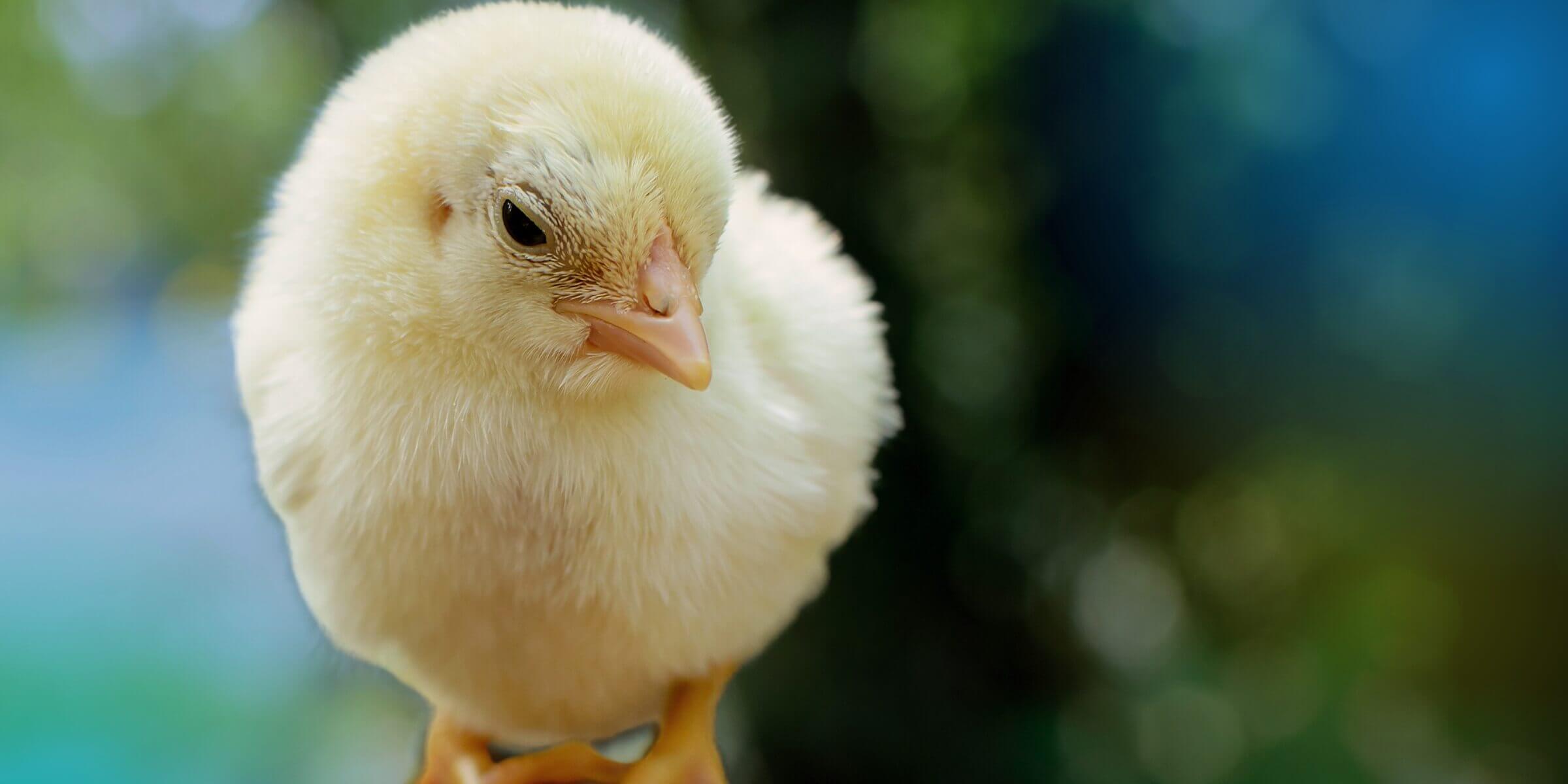Farmed Animals: How Factory Farming Affects Different Species

Of all the animals killed directly by humans, animals farmed for food are by far the most numerous. In the U.S. alone, we estimate that the number of land animals killed for food is 14,000 times higher than the number of dogs and cats euthanized in shelters—adding in farmed and wild-caught fishes makes the problem even bigger.1 Despite this large difference, most donations made to animal charities in the U.S. are directed toward companion animal shelters, with just 3% going to support farmed animal charities. Here, we take a closer look at the most commonly farmed species, how factory farming affects animals, the ethical issues with factory farming, and what you can do to help farmed animals.2
What Is a Farmed Animal?
A farmed animal is any animal that is bred, raised, and ultimately killed for food or other agricultural products. This broad category of animals includes vertebrates like chickens, fishes, cows, and pigs, as well as invertebrates like honey bees, silkworms, cochineals, and shrimps.
Why do we call them farmed animals?
Rather than calling them “farm animals” or “livestock,” ACE typically uses the term “farmed animals” to acknowledge animals’ individual worth and avoid reducing them to their use as commodities. The term “farm animals” implies that those animals exist solely to be farmed, which is untrue. Similarly, we typically avoid using agricultural or meat-related terms when discussing animals, as such terms can diminish their individuality and personhood. For instance, instead of using the plural term “fish,” we choose to use “fishes” when referring to multiple species or individual animals within the group. This choice reflects our belief that these creatures should be recognized as unique beings with their own identities, rather than being viewed merely as products or resources. By adopting this language, we aim to promote a greater awareness and respect for the lives of animals.
Why do we prioritize farmed animals?
We consider farmed animal advocacy a high-priority cause area because of the large number of individual animals who suffer on farms and the limited funding going toward helping them. Additionally, there are more proven and achievable methods to alleviate their suffering compared to other animal groups, such as wild animals. Among farmed animals, we prioritize farmed fishes, chickens, and invertebrates such as shrimps. Because they are farmed in the highest numbers, these are the most impactful groups to focus on.

What Animals Are Kept On Farms?
Below are a few of the most commonly farmed animal species that ACE targets in our work.
Chickens
Chickens are among the most abundant farmed animals, outranked only by farmed fishes and certain invertebrates, with an estimated 75 billion killed annually.3 When given enough space and an appropriate environment, chickens will forage for food, form nests and roosts, preen their feathers, and socialize with their flock. In contrast, chickens on factory farms live their entire lives in cramped, barren battery cages, or crowded together in a shed with thousands of others, with little to no room to turn around or stretch their wings. Though the best long-term outcome for chickens is to stop farming them, a more achievable short-term intervention is to reduce the suffering they experience by eliminating the use of battery cages and gaining them higher welfare standards. Initiatives like the Open Wing Alliance are working to make this a reality by encouraging companies to make cage-free commitments.
Fishes
As detailed in our Farmed Fish Welfare Report, existing research on fish welfare is limited, and the research that has been done tends to focus more on maximizing benefits for farms rather than fishes. While we believe that more research into promising ways to help farmed fish species is needed, we still believe that fish welfare should be prioritized within the broader effective animal advocacy movement. This is due to the current neglectedness of farmed fish animal welfare, the viability of potential strategies to improve farmed fish welfare, and the immense scale of fish farming—roughly 124 billion fishes are farmed in the world annually,4 with an additional 1.56 trillion caught in the wild each year, not including bycatch and discards.5
Cows
Cows are sensitive, social animals who can not thrive or carry out many of their natural behaviors in the poor, product-driven environments of meat and dairy farms. Although killed in smaller numbers than fishes or chickens, beef has the largest carbon and water footprint of all food products. Commercial beef production also has considerable land use costs and is a key driver of deforestation and biodiversity loss. One unfortunate solution to mitigate some of the land use and deforestation caused by cow farming is to replace pasture with intensive confinement systems; this undoubtedly increases cow suffering, and still requires land to be cleared to grow crops fed to livestock. A more humane solution to ending cow suffering is to reduce demand for beef and dairy products by encouraging plant-based diets and developing food alternatives.
Shrimps
Unlike other invertebrates, it is more widely accepted that decapod crustaceans (e.g., shrimp, crabs, lobsters) and cephalopod mollusks (e.g., octopus, squid) are sentient creatures. In 2022, the sentience of both animal groups was officially recognized in U.K. law—an extremely promising development for organizations working to improve welfare conditions in aquatic animal farms. One such organization is our Recommended Charity Shrimp Welfare Project, which pursues interventions to improve welfare standards on shrimp farms.
Pigs
Around 1.5 billion pigs were slaughtered worldwide in 2022, according to data reported by the United Nations Food and Agriculture Organization (FAO).6 Pigs are highly intelligent animals with a deep capacity for emotional connection. In factory farms, mother pigs are crammed into barren gestation crates so small that they cannot turn around or extend their limbs. Perhaps worse, pigs on factory farms are denied the ability to form social bonds or showcase their unique personalities. To improve pig welfare, advocates are working to ban the use of stalls and gestation crates.
Ducks and turkeys
FAO data from 2022 estimates that more than three billion ducks and 500 million turkeys are slaughtered annually around the world.7 China and the European Union are the main producers of ducks, utilizing them for meat, eggs, feathers, and specialty products such as foie gras. Meanwhile, turkeys are mainly farmed in the U.S. for their meat, where they are heavily associated with holiday traditions like Thanksgiving and Christmas. Potential interventions to improve the conditions for ducks and turkeys include advocating for higher-welfare farming practices and promoting alternative products such as plant-based meat and artificial down.
Goats and sheep
According to FAO statistics, over 500 million goats and 630 million sheep were slaughtered worldwide in 2022.8 These animals are primarily farmed for their meat, milk, and wool, which are used to produce food and textile products. Both goats and sheep spend much of their time on factory farms in tight, restrictive stalls that prevent them from engaging in natural behaviors; farmed goats are unable to climb, run, play, or forage, and farmed sheep are unable to graze, flock, and bond with their herd. Innovations like animal-free meat and dairy products can help reduce demand for goat and sheep farming, along with textile alternatives to wool and cashmere.
Insects
Research on the sentience of insects and other invertebrate species is limited, but we do have evidence that some insects (including commonly-farmed species) feel pain. Data on the number of farmed insects that are killed each year is similarly lacking; however, estimates indicate that many subgroups of farmed insects are more numerous than the total number of farmed vertebrates, with estimates for honey bees and cochineals numbering in the trillions.9 Due to the massive scale of farmed insects, the neglectedness of their interests, and the likelihood of their potential sentience, we believe pursuing interventions that could improve their welfare is worthwhile.

How Many Farmed Animals Are There?
We estimate there are about 35 billion farmed land animals and 77 billion farmed fishes alive at any given time, with an estimated 83 billion farmed land animals and 124 billion farmed fishes killed for food each year.10 In comparison, there are only about 840 million dogs and cats and around 190 million animals used in labs.11 This means that farmed animals comprise more than 99% of all domesticated animals worldwide. This estimate notably excludes farmed invertebrates, who likely number well into the trillions.
What animal is farmed the most?
Certain invertebrates, fishes, and chickens are the most commonly farmed animal species. Given the significant number of animals involved, we believe that efforts to improve the welfare of these groups of animals are particularly promising.
How Does Factory Farming Affect Animals?
Although we cannot fully comprehend the emotions of farmed animals, we can use welfare indicators to gauge the extent of their suffering. For instance, welfare indicators show that certain factory farming methods, such as cage-free hen housing instead of battery cages, provide a better quality of life for animals by enabling them to engage in their natural behaviors. Although no factory farming system is ideal, promoting higher-welfare practices (or better, plant-based diets) can decrease the amount of suffering experienced by farmed animals.
What Are The Ethical Issues With Factory Farming?
Factory farming prioritizes maximizing agricultural output at the expense of animal welfare and other concerns, such as environmental impacts, workers’ safety, and public health risks. Despite some attempts to address these concerns, the industrial agriculture sector resists implementing measures that could increase operating costs or reduce potential sales. The result is an unsustainable industry that perpetuates widespread animal suffering, extensive land and water usage, unsafe labor practices, and pollution from greenhouse gases and industrial waste.
Which Laws Protect Farmed Animals?
Laws that protect farmed animals vary significantly across countries and are enforced to different degrees. While the nation-based nature of most legal systems makes it difficult to generalize the global effects of farmed animal welfare laws, available evidence suggests that legal work by animal welfare groups can contribute to changes and modifications in the law, help ensure law enforcement, and motivate cultural shifts in societal attitudes toward animal welfare.
What Can You Do To Help Farmed Animals?
There are many things you can do to help farmed animals. If you’d like to learn more, you can sign up for our free guide on how to help farmed animals. We created this guide because we want to help people help animals. It aims to provide you with insights into why we should care about the cruelty against farmed animals and practical ways you can create meaningful change for them.
You can also help by donating to our Recommended Charity Fund, our Movement Grants program, or ACE is an excellent way to improve the lives of farmed animals. To learn more about these giving options, please visit our donation page. Together, we can create a world where every animal is treated with kindness and respect.
To calculate this figure, we used this data spreadsheet and divided the total number of farmed animals slaughtered in the U.S. (in cell B10) by the number of cats and dogs euthanized in U.S. shelters (in cell B2).
For more details on the data we used, please see this spreadsheet.
Ritchie et al. (2023) for Our World in Data. Our World in Data bases their analyses on data from the Food and Agriculture Organization (FAO).
See “How We Prioritize Causes” for more information on the data we used.
See “How We Prioritize Causes” for more information on the data we used.
About Selena Darlim
Selena joined ACE in September 2021. She is a longtime animal advocate with several years’ experience writing for nonprofits and media organizations. She holds a self-designed bachelor’s degree in Wildlife Conservation and Animal Advocacy, and she strives to continually expand her knowledge of human and nonhuman advocacy movements.
ACE is dedicated to creating a world where all animals can thrive, regardless of their species. We take the guesswork out of supporting animal advocacy by directing funds toward the most impactful charities and programs, based on evidence and research.



